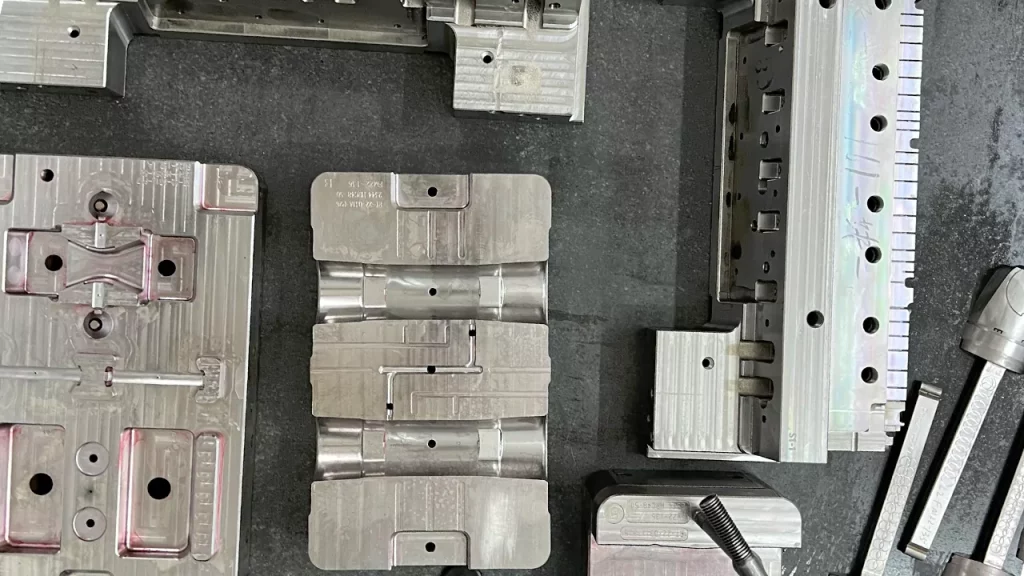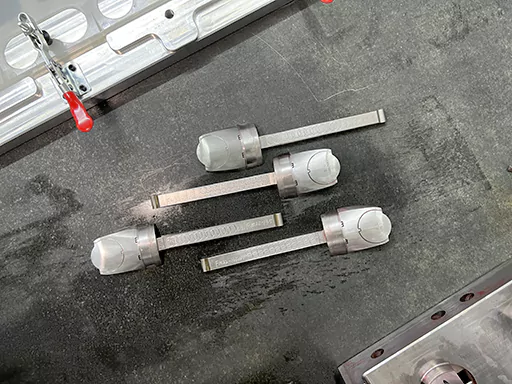If you’re planning to produce a plastic part using moldagem por injeção, you’ll need to familiarize yourself with the essential injection mold components. From the abeto to the sub-runner and exhaust port, each component plays a vital role in the injection molding process. However, if you’re new to injection molding, you may find yourself lost in a sea of technical jargon and unfamiliar terms.
We have you covered whether this is your first time learning about the injection molding process and its components or you’re independently venturing into this business with little understanding.
In this article, we’ll explain the various injection mold components and when they’re utilized, so you know what you’re getting into. So, without further ado, let’s get into the specifics.

8 Key Injection Mold Components
So what determines the quality and specifications of the plastic product you set out to manufacture using injection molding? The components of injection molding determine the quality, efficiency, design accuracy, finishing, and performance of the product. Choosing the right components during the injection mold process ensures that your product complies with the necessary production checklist.
Let’s explore some primary components in detail among the multiple injection mold components below.
Mold Base
The mold base is a fundamental component in injection molding, serving as the backbone of the mold assembly. Made from durable steel or aluminum alloy, it provides stability and support to withstand the pressures and forces involved in the injection molding process.
Comprised of a cavity plate, core plate, and various mounting features, the mold base securely holds and positions these plates to create the necessary cavities and cores for shaping the final product. It incorporates guide pin holes and alignment locks to maintain precise alignment between mold halves, ensuring accurate linha de separação matching.
Ejector pin holes are also present in the mold base, allowing for the proper ejection of finished parts by ejector pins. This feature ensures smooth part removal without causing any damage. Additionally, the mold base often includes cooling channels to circulate cooling media, enabling efficient and consistent cooling of the mold and optimizing part quality.
Runner System
The runner system is an essential element in injection molding that allows molten material to flow from the abeto to the individual cavities of the mold. It comprises a network of channels or passages designed to distribute the material evenly, ensuring proper filling of the mold and consistent part quality.
The main purpose of the runner system is to provide a pathway for the material. It starts with the sprue, connecting the máquina de moldagem por injeção nozzle to the mold. From there, the material flows through the runners, which are branching channels directing the material to each cavity. The design of the runner system is crucial for achieving balanced filling and minimizing variations in flow.
The size, shape, and number of runners depend on factors like part geometry, material viscosity, and molding parameters. Proper balance between the runners is crucial to prevent issues such as uneven filling or air entrapment. Advanced options like hot runners offer greater control over material flow.
In addition to distributing the material, the runner system aids in the cooling process. By incorporating cooling channels alongside the runners, it helps regulate the material’s temperature as it passes through the mold. This controlled cooling promotes solidification and shorter cycle times, enhancing overall productivity.
Maintaining and optimizing the runner system is important for efficient molding. Regular cleaning and inspection prevent blockages or buildup. Careful runner design, including dimensions, gate locations, and flow balance, can optimize part quality and production efficiency.
Ejector Pins
Ejector pins are an integral part of the injection molding process, serving the crucial function of removing the finished molded part from the mold cavity. They are typically located in the core plate of the mold and are activated by the ejection system of the injection molding machine.
The primary purpose of ejector pins is to push the solidified material out of the mold once the molding process is complete. They apply force to the back of the part, dislodging it from the cavity and allowing for easy removal. The size, number, and placement of ejector pins depend on factors such as part geometry, mold design, and ejection requirements.
Ejector pins are usually cylindrical in shape with a rounded or flat end. They are made from hardened steel to withstand the forces involved in the ejection process and ensure longevity. The pins must be precisely positioned and aligned within the mold to ensure consistent and accurate ejection of parts.
Efficient ejection is crucial for maintaining production speed and minimizing downtime. Improper ejection can lead to part damage or distortion, resulting in rejects and reduced productivity. Therefore, proper design and maintenance of the ejector pin system are vital.
Regular inspection and lubrication of ejector pins are necessary to ensure smooth operation and prevent any sticking or binding issues. Over time, ejector pins may wear out and require replacement to maintain optimal performance.
Sistema de arrefecimento
The cooling system in injection molding is responsible for regulating the mold temperature during the molding process. It consists of channels or passages within the mold that allow the circulation of cooling media, typically water or oil, to extract heat from the molten material and promote solidification.
The cooling system is essential for achieving high-quality parts with minimal defects. By controlling the cooling rate, it helps prevent warping, shrinkage, and internal stresses in the molded parts. The channels are strategically designed to provide even cooling across the mold, with closer placement to areas that require more heat dissipation.
Regular maintenance of the cooling system, such as cleaning and monitoring flow rates and temperatures, ensures efficient cooling performance. By optimizing the cooling process, manufacturers can enhance part quality, dimensional accuracy, and overall production efficiency in injection molding.
Guide Pins And Bushings
T are essential components in injection molding that ensure accurate alignment and smooth movement between mold halves. Guide pins, typically placed in one mold half, fit into bushings embedded in the opposite half, creating a sliding or rotating mechanism. This mechanism allows for precise alignment, ensuring consistent parting line matching and preventing defects. Guide pins and bushings also provide stability and support, minimizing friction and binding during mold operation. Regular maintenance and inspection are important to address wear or damage promptly and maximize their effectiveness in achieving high-quality molded parts.
The Mold Venting System
The mold venting system is an important component in injection molding that removes trapped air or gases from the mold cavity. It prevents defects and ensures proper filling of the cavity for high-quality parts. Venting channels or grooves are strategically placed within the mold to allow air to escape without affecting material flow. Regular maintenance and cleaning are necessary to prevent blockages and ensure effective venting. The venting system plays a critical role in achieving defect-free molding and maintaining part quality.
Hot-runner System
The hot-runner system is an advanced injection molding technique that eliminates the need for runners and sprues. It features a heated manifold connected to individual gates, allowing molten plastic to be directly injected into the mold cavities. This system reduces material waste, improves part quality, and offers flexibility in molding operations. With precise temperature control, it ensures consistent and efficient production of high-quality molded parts. Proper maintenance is crucial for optimal performance and cost-effective operation of the hot-runner system.
Deslizar
Slides are important components in injection molding that enable the production of complex parts with features such as undercuts or side holes. They are typically used in conjunction with the mold’s core and cavity plates to create additional movement and functionality.
Slides work by enabling the mold to move in different directions, perpendicular to the direction of the injection. They are mounted on the mold and are actuated by the injection molding machine. Slides allow for the creation of intricate shapes or features that cannot be achieved with a simple two-plate mold.
The design and construction of slides require careful consideration to ensure smooth movement and proper alignment. They must be accurately positioned and guided to avoid any binding or interference during the molding process. Slides are typically made from hardened steel or other materials that can withstand the forces involved in injection molding.
Proper maintenance and lubrication of slides are crucial for their optimal performance. Regular inspection helps identify any signs of wear or damage, allowing for timely repairs or replacements. Smooth operation of the slides contributes to the overall efficiency and quality of the injection molding process.

Conclusão:
Overall, it’s safe to say that plastic manufacturing would be impossible without injection mold components. For smooth and efficient mold operation, it is crucial to use key components like base, cavity inserts, and ejector pins.
Some other important elements that can affect the quality and durability of the mold components include the materials used, the accuracy of the manufacture, and the care with which they are maintained.
Companies today can make plastic goods that are up to snuff, thanks to their knowledge of the relevance of these parts and their collaboration with seasoned and trustworthy producers. Injection mold components will remain critically important to the plastics sector even as technology and materials advance.










